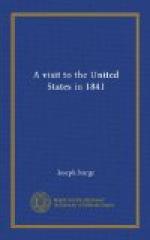I visited at this time the celebrated Schuylkill waterworks, which are beautifully situated on the river of that name. The water is raised to large reservoirs, at a higher level than the tops of the houses, by pumps worked by the current of the river. The supply not only suffices for the domestic use of the inhabitants, but is abundant for every public purpose of ornament or utility. My kind host, Samuel Webb, who accompanied me, pointed out a plot of land, presented by William Penn to a friend, to enable him to keep a cow, which is now worth many hundred thousand dollars for building purposes. He also showed me a mansion, the late proprietor of which had received a large accession of wealth from the quantities of plate which had been shipped to him in coffee barrels from St. Domingo, on the eve of the revolution in that Island, and whose owners are supposed to have subsequently perished, as they never appeared, with one solitary exception, to claim their property.
It will be necessary, in order to make certain passages of the succeeding narrative intelligible to my readers in this country, that some account should be given of the schism which has recently taken place in the once united and compact organizations of the abolitionists.
The American Anti-Slavery Society, whose origin has been already described, acted with great unity and efficiency for several years; auxiliaries were formed in all the free States; it scattered its publications over the land like the leaves of autumn, and at times had thirty or forty lecturers in the field. It kept a steady and vigilant eye upon the movements of the pro-slavery party, and wherever a vulnerable point was discovered, it directed its attacks. In its executive committee were such men as Judge Jay, Arthur and Lewis Tappan, La Roy Sunderland, Simeon S. Jocelyn, (the early laborer on behalf of the free colored people,) Joshua Leavitt, Henry B. Stanton, and the late Dr. Follen, a German political refugee, equally distinguished for his literary attainments and his love of liberty.
Until the last three or four years, entire union of purpose and concert of action existed among the American abolitionists. This harmony was first disturbed by the course pursued in the Boston Liberator. The editor of that paper, William Lloyd Garrison, whose early anti-slavery career has already been alluded to, and who was deservedly honored by the great body of the abolitionists, for his sufferings in their cause, and for his triumphant exposure of the oppressive tendencies of the colonization scheme, had always refused to share with any society or committee, the editorial responsibility of his journal. About the time referred to, several pieces were inserted in the Liberator, questioning the generally received opinions on the first day of the week. These were followed by others on other subjects, and he continued to keep his readers apprised of the new views of ethics and theology, which from time to time were presented to




